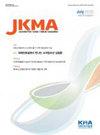成人脊柱畸形的诊断与治疗
IF 0.5
Q3 MEDICINE, GENERAL & INTERNAL
引用次数: 0
摘要
背景:成人脊柱畸形(ASD)的诊断率随着预期寿命的增加和脊柱退行性疾病的流行而增加。据报道,60岁以上的成年人中ASD的患病率高达68%。ASD对疼痛、残疾和心理健康有重大影响。因此,有必要通过积累现代ASD知识,发展手术技术,完善术前和术后护理,制定有效的手术方案,以达到最佳的手术效果。当前概念:ASD是由退行性疾病或医源性因素引起的冠状和矢状面排列异常引起的。近年来,矢状面对齐矫正的重要性得到重视,SRSSchwab分级法被普遍接受。通过充分的术前评估和影像学研究,可以设定个体化矫正目标,通过术中患者定位、前后路脊柱手术、螺钉固定、截骨等方法,可以实现适当的冠状位和矢状位矫正。讨论与结论:有必要为每位ASD患者建立最佳的矫正目标,选择合适的手术入路,以提高患者的生活质量。通过充分了解和预测围手术期并发症,ASD的手术干预可以安全地完成。本文章由计算机程序翻译,如有差异,请以英文原文为准。
Diagnosis and treatment of adult spinal deformity
Background: The diagnosis rate of adult spinal deformity (ASD) is increasing with increased life expectancy and the prevalence of degenerative spinal diseases. The prevalence of ASD in adults aged >60 years has been reported to be up to 68%. ASD has significant impact on the pain, disability, and mental health. Therefore, it is necessary to establish an effective surgical plan by accumulating modern knowledge on ASD, developing surgical techniques, and improving pre- and post-operative care so as to achieve optimal surgical outcomes.Current Concepts: ASD results from coronal and sagittal malalignments caused by degenerative diseases or iatrogenic factors. Recently, the significance of sagittal alignment correction has been emphasized, and the SRSSchwab classification of ASD is generally accepted. Individualized correction goals can be set through sufficient preoperative evaluations and imaging studies, and appropriate coronal and sagittal alignment correction can be achieved through intraoperative positioning of patient, anterior and posterior approach spine surgery, screw fixation, and osteotomies.Discussion and Conclusion: It is necessary to establish an optimal correction target and select the appropriate surgical approach for each patient with ASD, so as to improve patients’ quality of life. Surgical interventions for ASD can be safely completed by adequately comprehending and anticipating perioperative complications.
求助全文
通过发布文献求助,成功后即可免费获取论文全文。
去求助
来源期刊

Journal of The Korean Medical Association
Medicine-General Medicine
CiteScore
0.50
自引率
0.00%
发文量
84
审稿时长
4-8 weeks
期刊介绍:
The Journal of the Korean Medical Association (JKMA) is the official peer-reviewed, open-access, monthly journal of the Korean Medical Association (KMA). It contains articles in Korean or English. Its abbreviated title is ''J Korean Med Assoc''. The aims of the Journal include contributing to the treatment of and preventing diseases of public health importance and to improvement of health and quality of life through sharing the state-of the-art scientific information on medicine by the members of KMA and other national and international societies.
 求助内容:
求助内容: 应助结果提醒方式:
应助结果提醒方式:


